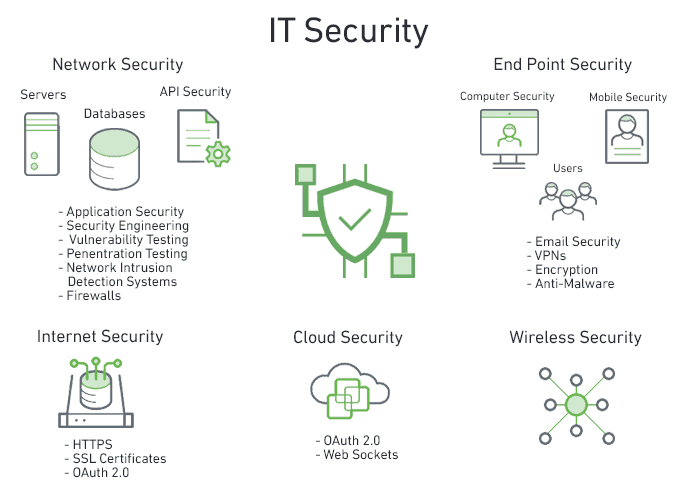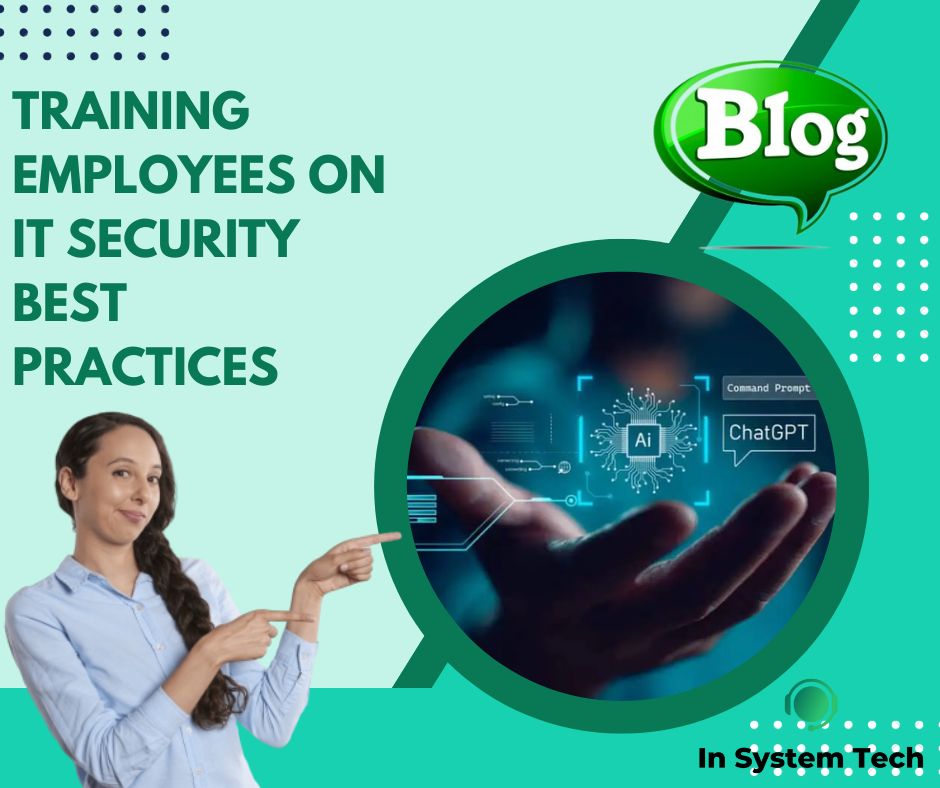Introduction:
Training Employees on IT Security: In the current digital environment, having robust information technology security is absolutely necessary for enterprises of all sizes. However, even having advanced security measures in place, employees still have the potential to unwittingly become a vulnerable link in the chain. Let’s discuss more about Training Employees on IT Security.

It is necessary to educate and train staff on the best practices for information technology security in order to reduce the risk of data breaches, cyberattacks, and other types of security incidents. In this article of a blog, we will investigate efficient methods for teaching staff on the most effective IT security best practices, with the end goal of improving the overall security posture of your company. Let’s discover more about Training Employees on IT Security.
Read More: What IT services are essential for a small business?
- Introduction:
- Create a Comprehensive IT Security Policy:
- Conduct Regular IT Security Awareness Training:
- Provide Cybersecurity Basics:
- Demonstrate Real-World Examples:
- Promote Password Hygiene:
- Raise Awareness about Phishing Attacks:
- Establish Secure Remote Work Practices:
- Educate on Data Protection and Handling:
- Foster a Culture of Vigilance:
- Provide Ongoing Training and Updates:
- Conduct Security Drills and Simulations:
- Lead by Example:
- Provide Accessible Resources:
- Regularly Assess and Update Training Programs:
- Stay Abreast of Regulatory Requirements:
- Conclusion:
Create a Comprehensive IT Security Policy:
Effective staff training must begin with the formulation of a policy that is both specific and all-encompassing about information technology security. Outline the expectations, norms, and processes that should be followed when it comes to the protection of data, the use of corporate equipment, the accessing of sensitive information, and the response to security problems. Ensure that each employee is aware of the policy and that they comprehend both its significance and the obligations that come along with it. Let’s discuss more about Training Employees on IT Security.
Read More: How much does small business IT support typically cost?
Conduct Regular IT Security Awareness Training:
It is important to educate staff about the most recent security dangers, best practices, and preventative measures, hence it is important to provide frequent IT security awareness training sessions. Include discussions on themes like “password hygiene,” “phishing awareness,” “social engineering,” “data protection,” “safe browsing habits,” and “social engineering.” These training sessions ought to be participatory and interesting, as well as adapted to the requirements of your particular company.

Provide Cybersecurity Basics:
Start with the basics of cybersecurity to ensure employees have a solid foundation. Cover essential topics such as the importance of strong passwords, the risks of sharing sensitive information, recognizing phishing emails, and the dangers of downloading files from unknown sources. Emphasize the role each employee plays in protecting the company’s digital assets. Let’s discuss more about Training Employees on IT Security.
Demonstrate Real-World Examples:
When demonstrating the implications of security breaches to employees, it is helpful to use real-world examples and case studies to engage their interest. Demonstrate how common security events take place and the potential impact they can have on individuals as well as organizations. In order to emphasize how important it is to implement security best practices, it is helpful to highlight the financial, reputational, and legal ramifications of not doing so.
Promote Password Hygiene:
The use of passwords is an essential component in the prevention of unauthorized access. Teach your staff how to generate secure passwords by having them use a combination of capital and lowercase letters, numbers, and any other special characters that may be needed. Encourage your users to create unique passwords for each of their accounts, and suggest that they use a password manager for added convenience as well as protection. Let’s discuss little more about Training Employees on IT Security.

Raise Awareness about Phishing Attacks:
Attacks via phishing continue to pose a serious risk to enterprises. Train your staff to recognise phishing emails, suspicious links, and misleading websites. Instruct them to check the identity of the senders of emails, to avoid clicking on strange attachments or links, and to report to the IT department any emails or activities that seem suspicious. Phishing simulations can be an excellent tool for teaching these types of topics to students. Let’s discuss few more about Training Employees on IT Security.
Establish Secure Remote Work Practices:
It is necessary to train staff on secure remote work practices, particularly in light of the surge in popularity of remote work. Put an emphasis on the utilization of virtual private networks (VPNs) for the establishment of secure connections, the significance of establishing secure Wi-Fi networks, and the dangers of utilizing personal devices for work-related responsibilities. Employees should be instructed on how to properly secure their home networks, and regular software updates should be encouraged.
Educate on Data Protection and Handling:
Employees should be educated on the correct handling of sensitive data as well as its protection. Insist that data be categorized and handled in accordance with the level of sensitivity it possesses, that it be encrypted when appropriate, and that data privacy standards be adhered to at all times. Employees should be instructed on safe methods for transferring files and the need of maintaining frequent data backups.

Foster a Culture of Vigilance:
Create an environment where employees are encouraged to be vigilant and where they are given the authority to report suspected security issues and threats. Create unmistakable lines of communication through which incidents or suspicious actions can be reported. Inspire your workforce to take an active role in the search for security flaws and encourage them to communicate their concerns directly to the IT department.
Provide Ongoing Training and Updates:
Because of this rapid evolution, continuing education is absolutely necessary for IT security professionals. Employees should be kept informed about emerging risks, new attack vectors, and updated security policies by regularly scheduling refreshers and updates to keep them up to date. Employees should be kept up to date on the most recent security developments through the provision of resources like as newsletters, security bulletins, and online training courses.

Conduct Security Drills and Simulations:
Create fictitious security situations and hold drills in order to evaluate the employees’ ability to respond and their level of expertise. This can consist of simulated malware assaults, tabletop exercises, or imitation phishing campaigns. The goal is to evaluate how well staff respond to security problems. Make the most of these exercises by using them as chances to reinforce training, determine areas that need development, and recognize staff for their alertness. Let’s find more about Training Employees on IT Security.
Lead by Example:
The leadership of an organization is responsible for a significant portion of the tone that is set for the IT security practices. It is imperative that executives and managers set a good example by prioritizing their own IT security in both their actions and communications. When employees perceive that their leaders take security seriously, it increases the likelihood that the employees will do the same.
Provide Accessible Resources:
Facilitate employees’ access to the various resources available for IT security. Establish a central location for all of the documents, rules, and training materials that pertain to security. It would be helpful if you could provide quick-reference instructions, a list of frequently asked questions, and contact information for the IT support team. In situations when they may require assistance or clarification, employees should be encouraged to seek it out.

Regularly Assess and Update Training Programs:
Maintain a consistent process for monitoring and analyzing how successful your IT security training programs are. It is important to conduct evaluations, keep track of security occurrences, and collect input from employees in order to identify areas for improvement. Maintain a level of awareness regarding newly discovered dangers and advancing standards of care to ensure that your training programs continue to be effective and current.
Stay Abreast of Regulatory Requirements:
Maintain an awareness of the specific regulatory obligations imposed by your industry in regard to the privacy and safety of data. Make sure that the training programs you use for IT security are in line with these standards and that they contain special compliance training where it is required. Assist employees in understanding the obligations placed on them as well as the potential repercussions of failing to comply.
Conclusion:
To protect the digital assets of your company, it is essential to provide personnel with training on the latest and greatest information technology security practices. You may greatly improve the security posture of your organization by developing a thorough IT security policy, cultivating a culture of vigilance, doing frequent awareness training, supporting good password hygiene, raising knowledge about phishing attacks, and conducting regular awareness training.
Your staff will be more likely to remain cautious and well-equipped to reduce potential security risks if you provide ongoing training, set a good example for them to follow, and routinely evaluate and update the training programs they participate in. It is important to keep in mind that investing in the education and training of employees is a preventative strategy that may increase the security of your company and defend it from evolving cyber threats. Powered By : Argusdna, Intergral Systems, Pixelcrafters


